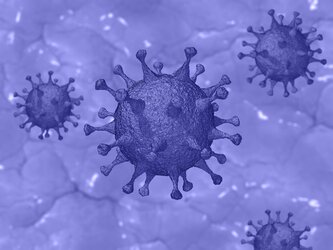COVID-19: how ESA reacted and helped prepare for the future
From using Earth observation satellites to measure the impact of lockdowns to testing medicine on the International Space Station… on World Health Day 2022, we look back at how ESA's services, data and technologies have supported the COVID-19 response effort and could help humanity prepare for future pandemics.
NOTE: For a detailed review of how ESA supported the COVID-19 rapid response effort in the first six months of the pandemic, see our previous article on this topic. The following article focuses more on the longer-term response, including the development of new tools, techniques and expertise that may prove useful when facing pandemics in the future.
Lessons learned in space – applied to Earth

The International Space Station (ISS) provides a one of-a-kind environment for scientific research. In the first example of COVID-19 research taking place on the ISS, scientists have been using Europe's commercial ICE Cubes Service to test a COVID-19 medicine in microgravity. The aim was to better understand how remdesivir interacts with its delivery substance cyclodextrin so that the drug's efficiency can be improved.

Aside from helping with vital research, ESA astronauts – as well as doctors and engineers who spend time on the Concordia research station in Antarctica – are masters of confinement. At the start of the pandemic, ESA flight surgeon Adrianos Golemis gave his tips for life in isolation (part 1 and part 2), having spent over a year away from loved ones whilst working at Concordia. ESA astronaut Samantha Cristoforetti also took part in a Reddit 'ask me anything' session together with a doctor and engineer to answer questions about how they have coped with isolation as part of their work.
A unique view of Earth

From their vantage point high above Earth's surface, Earth observation satellites have been useful in the COVID-19 response effort. For example, some Earth observation satellites observe trace gases in Earth's atmosphere; the data they collected showed that air pollution declined in early 2020 when lockdowns were put into place, then was returning to pre-COVID levels by early 2021.
Aware that there are myriad ways that satellite data could be used, in early 2020, ESA launched a contest asking the general public to submit ideas on how Earth observation data could help monitor the impacts of the pandemic. Two of the winning ideas were integrated into the 'Rapid Action on COVID-19 with Earth observation' (RACE) dashboard – a joint initiative from ESA and the European Commission. One idea involved an innovative solution for detecting and quantifying the number of trucks using imagery from the Copernicus Sentinel-2 mission. The other idea focused on monitoring air traffic in Europe, also using imagery from Sentinel-2. The inclusion of both ideas into the dashboard could support measurements of the impacts of coronavirus lockdowns on the economy, agriculture, and the environment, and help monitor post-lockdown recovery.

In March 2021, ESA and the European Commission launched a new series of monthly challenges asking for innovative solutions for how Earth observation satellite data can be used to help better understand the effects of COVID-19 on society. The best ideas have also been integrated into the RACE dashboard.
In June 2021, ESA, NASA and JAXA hosted a hackathon that invited the public to use Earth observation data to solve challenges related to the pandemic. More than 4300 participants from 132 countries took part, with the hackathon covering a wide range of topics such as air and water quality, economic, social and agricultural impacts, and greenhouse gas effects. The hackathon winners included a team that used Copernicus Sentinel-3 data to enable people to chart changes in water quality, as well as the drivers of those changes, and a team that used data from the Tropomi instrument on the Copernicus Sentinel-5P satellite to track ship movement and measure air pollution close to shipping lanes.

Earth observation data can also be useful to economists and traders: alternative data specialist QuantCube Technology worked with ESA to apply artificial intelligence and deep learning techniques to Earth observation data to create a new set of economic indicators. Covering urban growth, nitrogen dioxide levels, water stress and agriculture, these indicators helped illuminate how the world responded to life under COVID-19.
Space-based solutions
One responsibility of ESA's Telecommunications and Integrated Applications (TIA) directorate is to develop space-based applications that provide solutions to the needs of European citizens and society at large.

Through ESA Space Solutions, TIA has been supporting companies to use space-based products and services to tackle the COVID-19 pandemic. A huge variety of successful projects have emerged from this scheme over the past 18 months. In one, telecommunications allowed medical teams to remotely monitor people with chronic illnesses, helping them avoid exposure to the virus. Another used space data and ground-based information to generate maps which identify potentially at-risk communities that may be off the radar.
Other recent ESA Space Solutions projects include the development of a web application to support public health decision makers to manage the outbreak, a gamified e-learning platform, a device helping doctors to monitor vulnerable COVID-19 patients, a sanitisation system to sterilise and monitor the cleanliness of emergency medical vehicles, and a space-enabled drone delivery process to transport medical supplies in Scotland.

Although it's difficult to measure the impact that these new products and systems have had on the COVID-19 pandemic, it is safe to say that they were successful pilot projects for how space might be able to help in any similar situation that we may face in the future. For now, following the pandemic-induced economic crash, ESA has several green initiatives to foster economic recovery while promoting clean living and digital transformation. These initiatives seek to use disruptive technologies to transform urban green areas, improve air quality and offer space-based services for marine energy. They fit in with the European Commission’s green recovery plan that incorporates the EU Green Deal, which aims to make Europe carbon neutral by 2050.




